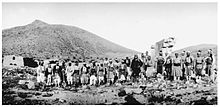Binbirkilise
Coordinates: 37 ° 26 '14 " N , 33 ° 8' 39" E
As Binbirkilise ( German 1,001 churches ) is an area in the ancient region of Lycaonia around the volcano Karadağ in today's Turkish province of Karaman referred. There are around 50 Byzantine church ruins in the area. The area is located on the northern slope of the Karadağ massif about 30 km north of the provincial capital Karaman . The ruins are near and in the places Madenşehri, Üçkuyu and Değle.
buildings
The area was a cultural center for Byzantine Christians in the third through eighth centuries . There are remains of churches, monasteries, fortifications, cisterns and houses, some of which have been integrated into today's villages or whose stones have been used as building material. As a result, the number of buildings has continuously decreased. The multiple dome basilicas of the Syrian type are interesting in terms of architectural history . The walls were built from large blocks. Because of the lack of wood, stone domed roofs were used here instead of the usual flat wooden roof. Over the aisles , galleries are built behind the upper row of columns . In the apses there are double arcade windows , the entrance areas mostly have double arcades and are supported by a single column in the middle. In some of the churches, especially in Madenşehri, remains of wall paintings can be seen. There are also some relics from the Hittite , Hellenistic and Roman times in the area.
Research history
In 1904 Carl Holzmann published his Archaeological Sketches for Binbirkilise. Shortly thereafter, it was rewritten by the British traveler and archaeologist Gertrude Bell , who explored the region in 1905 while traveling through Asia Minor . She published her travelogues including numerous photos in a series of articles in the Revue archéologique . On the same trip she met the archaeologist William Ramsay in Konya and the two decided to carry out excavations in Binbirkilise. In 1907 the excavation work took place, the results were published, again with many pictures, of both in the book The Thousand and One Churches . When Bell returned two years later, she found that a large part of the documented buildings had disappeared due to stone robbery. Bell's pictures show that in the meantime the destruction of the building fabric has progressed further. The Turkish art historian Semavi Eyice researched the area and published his research in 1971.
literature
- Carl Holzmann: Binbirkilise: Archaeological sketches from Anatolia: a contribution to the art history of Christian church building , Verlag Von Boysen & Maasch, 1904
- William Mitchell Ramsay, Gertrude Lowthian Bell, Robert G. Ousterhout: The Thousand and One Churches , University of Pennsylvania Museum of Archeology and Anthropology, 2008, ISBN 9781934536056
- Semavi Eyice: Research archéologiques à Karadağ (Binbirkilise) et dans la region de Karaman. Doğan Kardeş, 1971
- Turgut Saner - Bilge Ar - Gizem Mater (ed.), Metin Ahunbay'ın İzinden: Ayatekla, Binbirkilise ve Dara / Anastasiopolis Araştırmalarından Özel Konular . Istanbul 2017, ISBN 978-605-4778-58-4
Web links
Individual evidence
- ↑ Marianne Mehling (Ed.): Knaurs Kulturführer in Farbe Turkey . Droemer-Knaur, 1987, p. 334, ISBN 3-426-26293-2
- ↑ Getzel M. Cohen, Martha Sharp Joukowsky: Breaking Ground: Pioneering Women Archaeologists . University of Michigan Press, 2006, p. 167 ISBN 9780472031740 on GoogleBooks
- ^ Robert G. Ousterhout: A Byzantine settlement in Cappadocia . Dumbarton Oaks, 2006, p. 171 ISBN 9780884023104 at GoogleBooks


